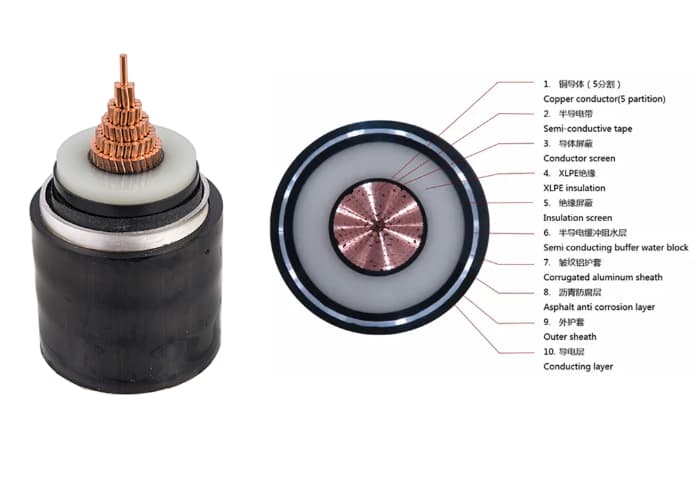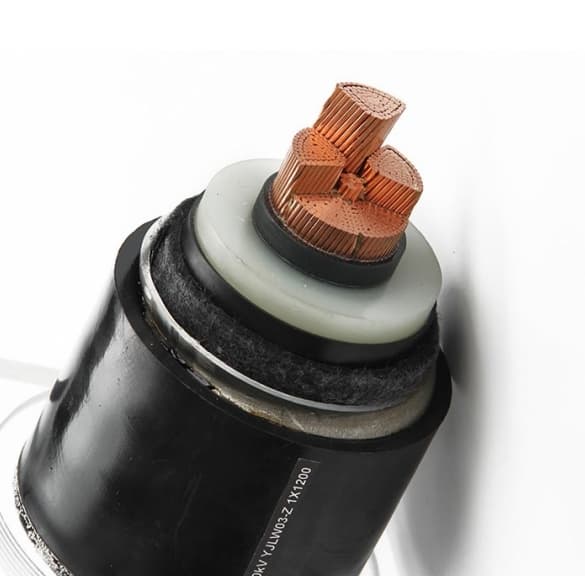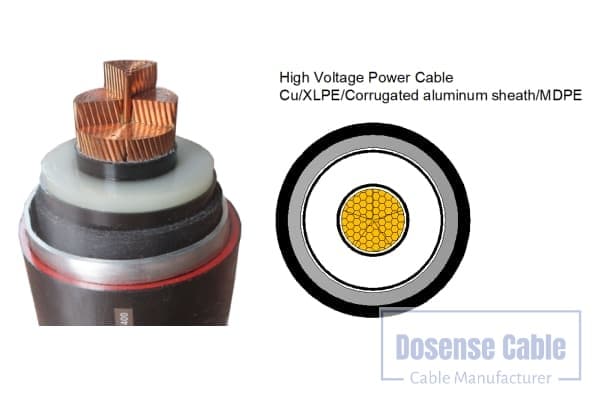Solar Cable, H1Z2Z2-K
High Voltage Cable are essential for underground high voltage transmission systems, especially in densely populated areas or environmentally sensitive locations where overhead lines are not feasible.
They offer efficient power transmission over medium distances while minimizing environmental impact and land use.
With advanced insulation materials and construction techniques, 66kV underground cables,132kV,230kV are designed to withstand higher electrical voltages and ensure long-term reliability.
Installation of these cables requires careful planning and coordination due to the complexity of the underground route and the need to navigate various obstacles such as existing infrastructure., bodies of water and geological conditions.
66kV, 132kV, 230kV High Voltage Cable
132kV High Voltage Cable

Construction of a high voltage cable (HV Cable) of 132 kV typically implies:
Conductor: usually made of copper or aluminum, carries electric current.
driver shield: Ensures a smooth transition between conductor and insulation.
Isolation: di-electric material such as cross-linked polyethylene (XLPE) provides stability and strength.
Isolation shield: protects insulation and helps distribute electrical stress evenly.
Metal shield: corrugated aluminum sheath or copper wire cable
External rod: provides mechanical protection against damage and environmental factors.
66kV High Voltage Cable

Drivers: copper or aluminum conductor.
Isolation: XLPE cross-linked polyethylene.
Armor: corrugated aluminum sheath or copper wire.
Funda: HDPE with semiconducting layer
Installation: Requires specialized equipment and experience due to the high voltage levels involved, with appropriate techniques necessary for security and integrity.
Testing and maintenance: Periodic tests, including insulation resistance tests and partial discharge measurements, are vital to ensure reliability and address potential issues.
In general, high voltage power cables 66 kV are critical components of electrical infrastructure, as they allow efficient and reliable transmission of electricity over long distances to meet the needs of industrial consumers, commercial and residential.
230kV High Voltage Cable

The high tension cable 230 kV is a type of electrical cable designed to transmit electricity at a high voltage level of 230.000 volts. These cables are used in electrical transmission and distribution systems to transport electricity over long distances with minimal losses..
Voltage rating: The voltage rating of 230 kV indicates the maximum voltage at which the cable can safely operate without breakdown or insulation failure.
Construction: These cables usually consist of a conductor, insulation and protective layers. The conductor is usually made of copper or aluminum and carries the electric current. The insulating material, such as cross-linked polyethylene (XLPE), insulates the conductor and prevents current leakage. The protective layers, such as metal shielding and outer coating, provide additional insulation and mechanical protection.
Lines of transmission: The cables of 230 kV are commonly used on overhead transmission lines or underground transmission systems to connect power generating stations, substations and distribution networks.
Efficiency: High voltage transmission reduces energy losses during electricity transmission, since higher voltages allow lower currents for the same power, resulting in reduced resistive losses in the cables.
Installation: Installation of cables 230 kV requires specialized equipment and experience due to the high voltage levels involved. Underground installations may involve digging trenches and laying cables, while aerial installations require the construction of transmission towers or poles.
Maintenance: Regular maintenance and monitoring are essential to ensure the reliability and safety of high voltage power cables.. This includes periodic inspections, Insulation integrity testing and repairs or replacements as necessary.
High voltage cable applications
High voltage cables are used in a variety of applications in electrical transmission and distribution systems.. Here are some of the main applications:
Electrical energy transmission: High voltage cables are used to transmit large amounts of electrical energy from generating plants. (as hydroelectric power plants, nuclear or wind energy) to substations and distribution points. These cables are essential for transporting electricity over long distances with minimal losses..
Interconnection between countries or regions: Submarine or underground high-voltage cables are used to interconnect electrical networks between countries or regions.. This allows the transfer of energy between areas with energy surpluses and those with high demand, improving the stability of the electrical system and the efficiency in the use of energy resources.
Connection of wind and solar parks: High voltage cables are used to connect wind farms and solar plants to the electrical grid. These renewable energy sources are often located in remote areas where the energy is optimally generated., and high voltage cables facilitate its integration into the national electrical grid.
Food for large industries: Large industries such as factories, Refineries and industrial complexes require a reliable, high-capacity electrical supply. High voltage cables provide the capacity needed to power these facilities and keep their operations running efficiently..
Urban distribution networks: In urban areas, High voltage cables are used in secondary and underground distribution networks to power substations and transformers, providing energy to homes, business and public infrastructure.
How to design high voltage cables?
The design of high voltage cables involves several technical and engineering aspects to ensure their optimal performance and safety.. Here are some key steps in the design process:
Application requirements: Understanding the specific needs of the application is essential. This includes determining the nominal voltage required, current capacity, transmission distance, the installation environment (Underground, submarine, air, etc.) and electrical load requirements.
Materials selection: Choosing the right materials is essential for cable performance. This includes selecting the conductor material (copper, aluminum or other), the type of insulation (XLPE, EPR, oil impregnated paper, etc.), shielding and outer covering materials.
Calculation of conductor cross section: Determine the size of the conductor based on the maximum current the cable will carry and the environmental conditions. This is done considering the allowable current capacity, voltage drop and heat dissipation.
Insulation design: Cable insulation must be designed to withstand the rated voltage and protect the conductor against short circuits and faults.. Factors such as resistance to aging must be considered, heat resistance and moisture resistance.
Shield design: High-voltage cables usually have a metal shield to protect the insulation and reduce the effects of the external electric field.. Shield design should ensure uniform electric field distribution and good current dissipation capacity.
Surge analysis: Surge analyzes should be performed to evaluate cable behavior under overvoltage conditions., like overloads, short circuits and atmospheric phenomena. This helps ensure insulation integrity and system security..
Accessories for high voltage cables
High voltage cable accessories play a crucial role in the efficient and safe transmission of electrical energy over long distances. Here you have a description in Spanish of some of the accessories mentioned:
Outdoor Terminals:
Porcelain Terminals for Outdoor Use: These terminals are designed with porcelain insulators for installation in outdoor environments. They provide excellent resistance to weather and adverse environmental factors.
Composite Terminals for Outdoor Use: These terminals are equipped with a composite jacket that offers greater protection against corrosion, humidity and other external elements.
GIS Terminals (Gas Insulated Substation):
These terminals are specifically designed for use in GIS substation systems, where gas is used as an insulator instead of air.
Oil Immersion Terminals:
These terminals are used in oil immersion applications, as in transformers, where oil is used as a dielectric and cooling medium.
Splice Joints:
Direct Splice Joints: These joints are used to directly connect two high voltage cables. They provide a safe and efficient connection for the transmission of electrical energy.
Insulated Splice Joints: These joints are designed with insulating materials to ensure a safe connection protected against possible short circuits or electrical shocks..

